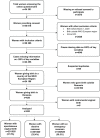Women's assessment of the quality of hospital-based perinatal care by mode of birth in Romania during the COVID-19 pandemic: Results from the IMAgiNE EURO study
- PMID: 36530009
- PMCID: PMC9877960
- DOI: 10.1002/ijgo.14482
Women's assessment of the quality of hospital-based perinatal care by mode of birth in Romania during the COVID-19 pandemic: Results from the IMAgiNE EURO study
Abstract
Objective: To assess women's perceptions of the quality of maternal and newborn care (QMNC) received in hospitals in Romania during the COVID-19 pandemic by mode of birth.
Methods: A validated anonymous online questionnaire based on WHO quality measures. Subgroup analysis of spontaneous vaginal birth (SVB), emergency cesarean, and elective cesarean and multivariate analyses were performed, and QMNC indexes were calculated. Maternal age, educational level, year of birth, mother born in Romania, parity, type of hospital, and type of professionals assisting the birth were used for multivariate analysis.
Results: A total of 620 women completed the survey. Overall, several quality measures suggested gaps in QMNC in Romania, with the lowest QMNC indexes reported for provision of care and availability of resources. Women who had either elective or emergency cesarean compared with those who had SVB more frequently lacked early breastfeeding (OR 2.04 and 2.13, respectively), skin-to-skin contact (OR 1.73 and 1.75, respectively), rooming-in (OR 2.07 and 1.96, respectively), and exclusive breastfeeding at discharge (OR 2.27 and 1.64, respectively). Compared with elective cesarean, emergency cesarean had higher odds of ineffective communication by healthcare providers (OR 1.65), lack of involvement in choices (OR 1.58), insufficient emotional support (OR 2.07), and no privacy (OR 2.06). Compared with other modes of birth, a trend for lower QMNC indexes for emergency cesarean was observed for all domains, while for elective cesarean the QMNC index for provision of care was significantly lower.
Conclusion: Quality indicators of perinatal care remain behind targets in Romania, with births by cesarean the most affected.
Gov identifier: NCT04847336.
Keywords: COVID-19; IMAgiNE EURO; Romania; breastfeeding; cesarean; childbirth; mode of birth; quality of care.
© 2022 The Authors. International Journal of Gynecology & Obstetrics published by John Wiley & Sons Ltd on behalf of International Federation of Gynecology and Obstetrics.
Conflict of interest statement
The authors have no conflicts of interest.
References
-
- Bratila E, Vladareanu S, The Ministry of Health . Metodologia privind naşterea la gravidele cu infecţie suspicionată/confirmată cu SARS‐CoV‐2/Covid19, preluarea, îngrijirea şi asistenţa medicală a nou născutului (Romanian) [Methodology regarding childbirth in pregnant women with suspected/confirmed SARS‐CoV‐2/Covid19 infection, taking over, care and medical assistance of the newborn]. Ministry of Health, 2020. Accessed May 15, 2022. http://www.ms.ro/wp‐content/uploads/2020/04/Metodologia‐privindnasterea‐...
-
- Suciu N, Nanu M, Stativa E, Novak C, Mihăilescu G. Study on the reproductive health in Romania. 2016. Accessed August 1, 2021. https://www.insmc.ro/wp‐content/uploads/2021/01/STUDIU_IOMC_final_23.09....
-
- Simionescu AA, Horobet A, Marin E, Belascu L. Who indicates Caesarean section in Romania? A cross‐sectional survey in tertiary level maternity on childbirth patients and doctors' profiles. Obstetrica Ginecologia. 2021;69:62.
Publication types
MeSH terms
Associated data
LinkOut - more resources
Full Text Sources
Medical


